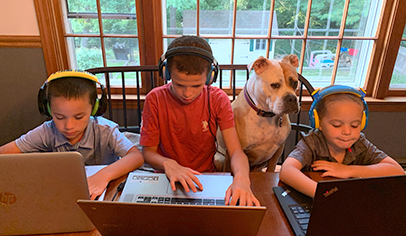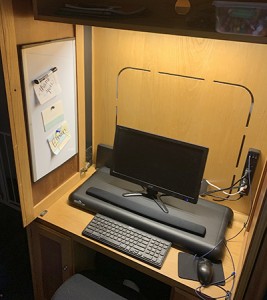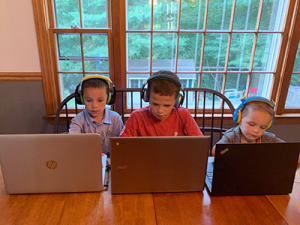Home Learning Setup Ideas and Tips
With virtual learning plans being rolled out by districts, parents are wondering how to create a homeschool room. Advice from parents: It really depends.
July 28, 2020

When the majority of schools across the country closed last spring, many parents had to figure out quickly not only how they’d do home learning, but also where. Not every home has an extra room to create a workspace with a desk and other accoutrements necessary. And even if they did, not every child even learns well in that setting.
As districts all over the U.S. are still figuring out how they’re going to reopen, many have announced there will be at least a portion of learning at home. In the meantime, parents have had a few months to consider the wheres, whens, and hows of their spring setups and have come up with creative and practical ways to make it work better for their families.
The Where
Jennifer Stach, a mom of two middle schoolers in Littleton, Mass., found their homework station less than ideal last spring. While her home’s open layout gave her sons space, she says, it only worked “as long as they weren’t on a call. If one was doing homework and the other had a meeting, it just didn’t work.”
Stach says she happened to have an old entertainment center, “and that led me into…wait a minute, if I take everything out, it’s a nice workspace.” So she did just that, resulting in an enclosed area her 11-year-old son calls “the learning box.”

Stach, who’s also an educator, recognizes that not all homes have the space, or recyclable furniture at the ready, to make their own “learning box.”
Depending on learning plans and kids’ ages, she says, “get creative with bedrooms.” This could mean using a small desk or even something that can function as a “desk,” like an old end table.
Michelle L., a homeschooling mom, says that without the space to have a dedicated homeschool room, her kids are used to learning in the spaces they have. “We primarily homeschool at the dining room table or in the living room—floor, floor pillows, coffee table, or couch.”
“I think kids benefit from being able to move in different ways throughout the day too, not sitting constantly at a desk or table to do all their work,” she says.
Jennifer Adler, a mom from Needham, Mass., who homeschools her two girls, suggests including kids in figuring out what works for them.
“[My] 14-year-old wanted the privacy of her room. Younger kids, like my 11-year-old, will likely want to be where you are,” she says.
Some parents caution that when it comes to planning a homeschool room or dedicated learning setup, prepare to make adjustments.
Rayann M., a mom of two, says that when learning went virtual last spring, she was able to create a learning space for her kids just by using what was around the house.
“My kids begged for a room with a desk setup and reading nooks. We didn’t spend any money and just repurposed what we had,” she says.
But it didn’t last.
“They only used that space for about a week and then ended up just finding wherever was comfortable at the time,” she says.
The When
If a home does have a spare room or office space, it can help to “schedule [learning] in shifts depending on who has Google chats, etc. To be rotating in and out depending on who needs a private space,” Stach says.
Scheduling differently rather than setting up revamped learning spaces is the plan for Jenn Shelley, a mom of three young boys, two of whom did their home learning at the kitchen table last spring.
If virtual learning continues in the fall, she says, she’ll need to keep them at the table “mainly due to their ages. That way I can keep an eye on them and make sure they are working and not playing games on the computer.”
What she would need to do differently in the fall, she says, is “try to do their schooling at separate times instead of at once. My husband and I are both working from home so it’s really challenging for us all to be working at once. So I would do one morning session and one afternoon session.”
“That way we are just fielding one set of questions while trying to get our own work done,” she says.

The How
Providing order and organization for kids of all ages can help them (and parents, too) get through home learning more smoothly.
For younger students
Keep a small basket or shoe box nearby with necessary (age-appropriate) supplies to get work done.
To the extent possible, stick to a bedtime hour and planned routine on every school night. For example: bath or shower, story, and bed.
Encourage them to organize their areas by purchasing small trays or paper folders where they can learn to file completed work, assignments due, etc.
For older students
Account for big kids having bigger needs. In Stach’s “learning box,” she says, “There is storage up above and on either side of the leg hole for any supplies or materials Ethan may need. It’s connected wirelessly to a printer so he can grind out his own worksheets.”
…and more clutter. A small accordion file with a slot for each subject is ideal for assignments they want to keep for the term or maybe even the whole year. A real clutter helper for a student with a computer and scanner is to scan key assignments and store them in an electronic desktop file to access later.
Adler recommends posting a schedule for every week and encouraging kids to check it often so they know what each day will look like.
Get your child's exact back‑to‑school supply list, right from their teacher.



